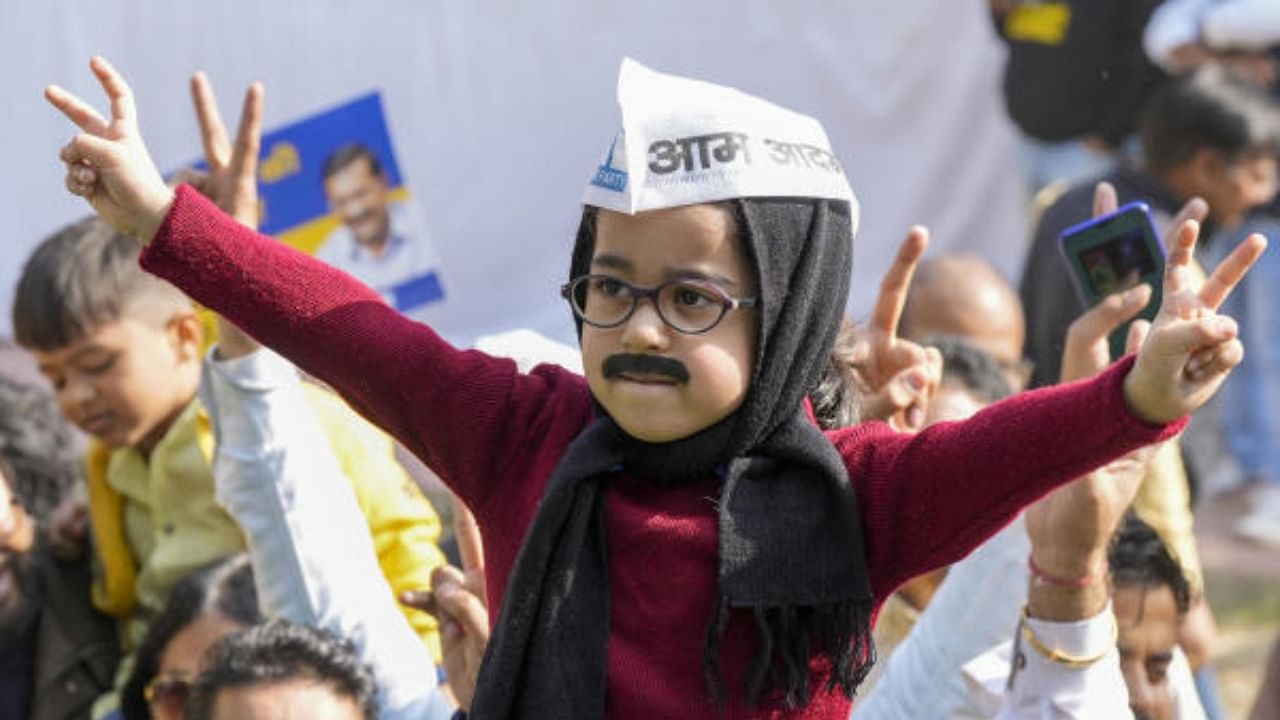
Politics is the art of selling credibility to buy popular support. An essential ingredient of this commodity up for sale is the image of the leader and the political party. The advantage that the Aam Aadmi Party (AAP) has in the political market is its image of being 'different', which people tired of a secular versus Hindutvawadi debate are opting for, and its credibility established in Delhi.
AAP's debut venture in Gujarat has generated a mixed reaction, and rightly so. Getting into a big state for the first time and securing nearly 13 per cent vote share is quite an impressive feat. More striking is that the new entrant has secured more than one-fourth of the opposition vote share (12.92 per cent out of 47.5 per cent).
However, this remarkable success has not been translated into a good number of seats, as more than half of the voters have preferred the ruling BJP, handing it 85 per cent of the seats. This skewed electoral outcome is a common phenomenon in the first-past-the-post electoral system followed by us. This has robbed AAP of the glamour that otherwise could have accrued.
The Gujarat feat, along with AAP's spectacular success in Punjab followed by Delhi Municipal polls, reflects a growing acceptance of the new party across states. With MLAs in Delhi, Punjab, Goa and Gujarat, AAP is rejoicing in its upcoming national status, but that is more symbolic than real. To turn itself into a real national party like the BJP or Congress, it still has a long, long way to go.
Read | Brand Modi takes a dent
Ironically, AAP leaders often show political immaturity as they get swayed by proximate developments. The latest example is Sanjay Singh's rhetoric. "Now it will be Narendra Modi versus Arvind Kejriwal in 2024," he said after the Assembly polls results on Thursday. To make it 'Modi versus Kejriwal', AAP had to first lift itself to a position of securing 50+ Lok Sabha seats.
Until now, the Congress is the only opposition party with the ability to cross the 50 mark. At present, AAP can win 25 seats at the most, and only if it wins all the seats of Punjab (13) and Delhi (7). With Bengal having 42 Lok Sabha constituencies and Tamil Nadu 39, the TMC of Bengal or DMK/AIADMK of Tamil Nadu can win more than 25 if they sweep their states.
So, AAP leaders will do better if they stop daydreaming and work hard to catapult the party to a position of strength in about 50/60 seats by 2024. Its natural targets should be north Indian states like Rajasthan, Himachal (which it abandoned this time for unknown reasons), Madhya Pradesh, Uttarakhand and the western part of UP.
AAP needs a long-term plan and efforts to build a strong organisation across these states, without which parties like the BJP (or the Left/TMC) cannot be fought on the ground. Gujarat has taught it the required lesson. A strong organisation helps people overcome the 'fear factor' (post-poll denial of government benefits or more major consequences) and rally with the opposition.
However, the effort will find its first victim in the Congress, which does not enjoy a robust organisational network like the BJP. Thus a space opens up in Rajasthan and Madhya Pradesh, where assembly elections will be held next year.
And herein comes the ideological stand of AAP. It has very intelligently shaped itself as equidistant from rabid Hindutva that targets Muslims and ultra-secularists who often appear anti-Hindu. Gujarat has proved that there is space for a soft Hindu party that is somewhat socialist in its economic outlook.
Gujarat has confirmed the signals from the voters across the state: AAP still has the possibility of shaping up as a third force. Perhaps people are tired of Hindutva and anti-Hindutva rhetoric dominating the political discourse and are more concerned about day-to-day life and livelihood. They are probably looking for an alternative that will neither appease nor hurt Hindus nor minorities and apply the law equally to all.
It means, theoretically, a shift of a chunk of voters from the BJP to AAP, too, is possible in the long run. Even now, we do not know whether, in AAP's absence in Gujarat, the BJP's vote share could not have gone up to 55 per cent instead of being stopped at 52.5. There could be a chunk of the population which does not favour the BJP anymore but is disinclined to vote for the secular camp. AAP is emerging as an alternative for them.
The morning shows the 10-year-old AAP has a bright future, and it can emerge bigger in 2024. It has the 'credibility' and 'being different' factors. However, beyond the Delhi-Punjab belt, it still needs to improve its organisational network, regular contact with the people on the ground, and the number of dedicated field workers. In short, it has the space, but that can dry up without proper political planning and organisational execution.
(Diptendra Raychaudhuri is a journalist and author based in Kolkata)
Disclaimer: The views expressed above are the author's own. They do not necessarily reflect the views of DH.